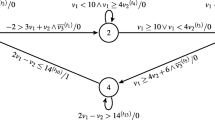Abstract
This article deals with the generation of exact diagnostic trees for real-size synchronous sequential circuits. Starting from existing detection-oriented test patterns, a modified fault simulator is used for assessing their diagnostic power, which, in general, is not satisfactory. A diagnostic procedure for improving it is described that successfully exploits symbolic FSM equivalence proof algorithms. In order to resort to costly techniques, such as product machine traversal, only when really needed, special checks are performed to verify combinational identity and identity on reachable states. As all faults are attributed to theirequivalence class, a complete and exact diagnostic tree can be built. Experimental results on ISCAS'89 circuits show the feasibility of the approach and support the claim that, for the first time, diagnosing real-world synchronous sequential circuits has become feasible.
Similar content being viewed by others
References
J.P. Roth, W.G. Bouricius, and P.R. Schneider, “Programmed algorithms to compute tests to detect and distinguish between failures in logic circuits,”IEEE Trans. on Electronic Comp., vol. EC 16, pp. 567–580, October 1967.
G.D. Hornbuckle and R.N. Spann, “Diagnosis of single-gate failures in combinational circuits,”IEEE Trans. on Comp., vol. C-18, pp. 216–220, March 1969.
D.C. Bossen and S.J. Hong, “Cause-effect analysis for multiple fault detection in combinational networks,”IEEE Trans. on Comp., vol. C-20, pp. 1252–1257, November 1971.
S.Y.U. Su and Y.C. Cho, “A new approach to the fault location of combinational circuits,”IEEE Trans. on Comp., vol. C-21, pp. 21–30, January 1972.
P. Camurati, D. Medina, P. Prinetto, and M. Sonza Reorda, “A diagnostic test pattern generation algorithm,”ITC'90: IEEE Int. Test Conf., Washington, DC, pp. 52–58, September 1990.
T. Grüning, U. Mahlstedt, and H. Koopmeiners, “DIATEST: a fast diagnostic test pattern generator for combinational circuits,”ICCAD-91: IEEE Int. Conf. on Computer Aided Design, Santa Clara, CA, pp. 194–197, November 1991.
M.A. Breuer, S.J. Chang, and S.Y.H. Su, “Identification of multiple stuck-type faults in combinational networks,”IEEE Trans. on Comp., vol. C-25, pp. 44–54, January 1976.
M. Abramovici and M. A. Breuer, “Multiple fault diagnesis in combinational circuits based on an effect-cause analysis,”IEEE Trans. on Comp., vol. C-79, pp. 451–460, June 1980.
M. Abramovici and M.A. Breuer, “Fault diagnosis in sequential circuits based on effect-cause analysis,”FTCS-10: 10th Fault Tolerant Computing Symp., Kyoto (Japan), pp. 313–315, October 1980.
R. Davis, “Diagnostic reasoning based on structure and behavior,”Journal of Artificial Intelligence, vol. 24, pp. 347–410, 1980.
B. Rogel-Favila and P.Y.K. Cheung, “Circuit representation and diagnosis using Prolog,”ISCAS'89: IEEE International Symposium on Circuits and System, Portland, OR, pp. 957–960, May 1989.
B. Rogel-Favila, A. Wakeling, and P.Y.K. Cheung, “Model-based fault diagnosis of sequential circuits and its acceleration,”EDAC'91: IEEE European Design Auto. Conf., Amsterdam, The Netherlands, pp. 224–229, February 1991.
G. Cabodi, P. Camurati, F. Corno, P. Prinetto, and M. Sonza Reorda, “Sequential circuit diagnosis based on formal verification techniques,”Proc. Int. Test Conf., Baltimore, MD, pp. 187–196, September 1992.
G. Cabodi, P. Camurati, F. Corno, P. Prinetto, and M. Sonza Reorda, “Cross-fertilizing FSM verification techniques and sequential diagnosis,”Proc. EURODAC, Hamburg, Germany, pp. 306–311, September 1992.
E.J. McCluskey and F.W. Clegg, “Fault equivalence in combinational logic networks,”IEEE Trans. on Comp., vol. C-20, pp. 1286–1293, November 1971.
M. Abramovici, M.A. Breuer, and A.D. Friedman,Digital systems testing and testable design, New York: Computer Science Press, 1990.
Z. Kohavi,Switching and finite automata theory, Computer Science Series, New York: McGraw Hill, 1970.
R.E. Bryant, “Graph-based algorithms for boolean function manipulation,”IEEE Trans. on Comp., vol. C-35, pp. 677–691, August 1986.
K.S. Brace, R.L. Rudell, and R.E. Bryant, “Efficient implementation of a BDD package,”Proc. 27th ACM/IEEE Design Auto. Conf., Orlando, FL, pp. 40–45, June 1990.
O. Coudert, C. Berthet, and J.C. Madre, “Verification of sequential machines using boolean function vectors,” IFIP International Workshop onApplied Formal Methods for Correct VLSI Design, Leuven, Belgium, vol. 1, pp. 111–128, November 1989.
O. Coudert and J.C. Madre, “A unified framework for the formal verification of sequential circuits,”ICCAD-90: IEEE Int. Conf. on Comp. Aided Design, Santa Clara, CA, pp. 134–137, November 1990.
O. Coudert and J.C. Madre, “Symbolic computation of the valid states of the sequential machine: algorithms and discussion,” 1991 International Workshop on Formal Methods in VLSI Design, Miami, FL, January 1991.
H. Cho, G. Hachtel, S.-W. Jeong, B. Plessier, E. Schwarz, and F. Somenzi, “ATPG Aspects of FSM verification,”Proc. Int. Conf. on Comp. Aided Design, Santa Clara, CA, pp. 134–137, November 1990.
H. Cho, G. Hachtel, S.-W. Jeong, B. Plessier, E. Schwarz, F. Somenzi, “Results on the interface between formal verification and ATPG,” DIMACS Series in Discrete Mathematics and Theoretical Computer Science, Volume 3, 1991:Computer-Aided Verification '90, (E. M. Clarke, R. P. Kurshan, eds.) pp. 615–628.
H. Cho, G. Hachtel, and F. Somenzi, “Fast sequential ATPG based on implicit state enumeration,”ITC-91: IEEE Int. Test Conf., Nashville, TN, pp. 67–74, October 1991.
G. Cabodi, P. Camurati, F. Corno, S. Gai, P. Prinetto, and M. Sonza Reorda: “A new model for improving symbolic Product Machine traversal,”Proc. 29th ACM/IEEE DAC'92, Anaheim, CA, pp. 614–619, June 1992.
F. Brglez. D. Bryan, and K. Koźmiński, “Combinational profiles of sequential benchmark circuits,”Proc. Int. Symp. on Circuits and Systems, Portland, OR, pp. 1929–1934, May 1989.
Author information
Authors and Affiliations
Rights and permissions
About this article
Cite this article
Cabodi, G., Camurati, P., Corno, F. et al. An approach to sequential circuit diagnosis based on formal verification techniques. J Electron Test 4, 11–17 (1993). https://doi.org/10.1007/BF00971936
Received:
Revised:
Issue Date:
DOI: https://doi.org/10.1007/BF00971936




